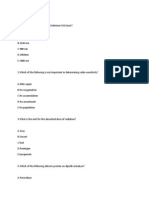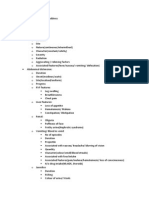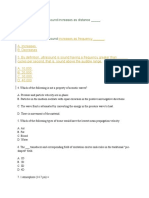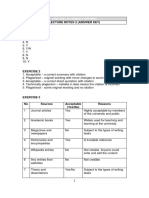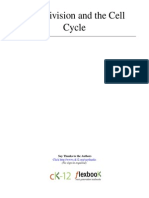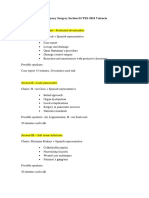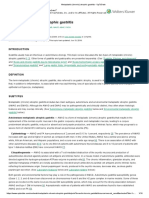Professional Documents
Culture Documents
Radiology MCQs
Radiology MCQs
Uploaded by
joeOriginal Description:
Copyright
Available Formats
Share this document
Did you find this document useful?
Is this content inappropriate?
Report this DocumentCopyright:
Available Formats
Radiology MCQs
Radiology MCQs
Uploaded by
joeCopyright:
Available Formats
Radiology MCQs
1.) Hypoventilation in cases of bronchial obstruction is caused by:
a. partial bronchial stenosis
2.) The presence of bilateral, multiple round shaped opacities on chest x-ray is
characteristic of:
b. pulmonary metastasis
3.) The lines of Kerle are due to:
a. interstitial lung edema
4.) The hemodynamic changes in left atrium in cases of isolated mitral stenosis are due to:
c. presence of residual blood during contraction of the left atrium
5.) The hypertonic stomach is:
a. High and obliquely situated towards the spine
6.) Chronic appendicitis has the following radiological signs:
b. retrocecal location of the appendix
7.) The screening method for diagnosis of diseases of the urogenital system is:
b. ultrasound examination
8.) The most frequent complication of renal colic is:
c. hydronephrosis
9.) Osteoporosis is a process of:
a. demineralisation
10.) Which of the following radiological signs cannot be referred to the degenerative
dystrophic disease (arthrosis) of the musculo-skeletal system?
b. calcification of the salt tissues
11.) Expiratory emphysema in bronchial obstruction is caused by:
b. bronchial valve stenosis
12.) Ring structures (?) on frontal chest radiography are characteristic of:
c. lung cavities
13.) Tear-shaped heart is:
a. normal heart
14.) Cardiac shadow increases its size in:
c. both answers are correct (a. cardiomyopathy; b. pericardial effusion)
15.) Normotonic stomach is:
b. situated on the left side of the spine and up the biiliac line
16.) The sign of „rice“ or „snowstorm“ is characteristic of
a. enteritis
17.) Which of the following methods is not useful in examination of the urogenital system?
b. HSG
18.) The method for primary diagnosis of hydronephrosis is:
c. ultrasonography of the kidneys
19.) In cases of diffuse osteoporosis which of the following changes occur?
a. Thinning of the compact bone, widening of the medullary channe/ bone marrow
spaces, Thinning of bone beams
20.) Which of the following methods is not used anymore?
a. pneumoencephalography
21.) Atelectasis in cases of bronchial obstruction is caused by:
c. complete bronchial stenosis
22.) Radiography of the paranasal sinuses is performed in:
b. standing or sitting position of the patient
23.) Which of the following cardiac chambers are normally not seen on the frontal chest
x-ray?
a. right ventricle
24.) The method of choice for diagnosis of pericardial effusion is:
b. echocardiography
25.) Hypotonic stomach is:
c. elongated and crossing the biiliac line
26.) In cases of suspected intestinal obstruction, the radiography of the abdominal region
is conducted in:
c. both answers (upright position, laterography in supine position)
27.) The plain radiography of the urogenital tract is a method:
b. which is used before each intravenous urography
28.) The main radiographic signs from intravenous urography in chronic pyelonephritis are:
a. changes in size and outlines of the kidneys
29.) Osteosclerosis is a process of:
b. hypermineralisation
30.) Perthes disease is:
b. aseptic necrosis
31.) Which is the most common cause for bronchial obstruction in children?
b. foreign body in the bronchus
32.) Which of the following diseases causes displacement of the mediastinum?
b. pleural effusion
33.) In cases of pericardial effusion the enlargement of the cardiac shadow on chest x-ray
is at:
c. Both left and right cardiac borders
34.) The changes of gastric peristalsis are result of disturbances of
a. tone and movement
35.) On plain radiographs of the abdomen, the air-fluid levels are characteristic of:
a. Ileus
36.) The retrograde pyelography is a method of examination, which gives information
regarding:
b. morphologic diseases of the genitourinary tract
37.) For the diagnosis of renal tumors we use:
c. CT of the kidneys
38.) Perthes disease is aseptic necrosis of:
a. head of the femur
39.) The x-ray appearance of lung abscess is:
c. air-fluid level in lungs
40.) Pneumoconiosis are:
c. occupational diseases of the lungs
41.) In supine position of the patient the cardiac shadow is:
a. bigger
42.) The most frequently used method for performing arteriography is:
b. puncture method of Seidinger
43.) The radiological symptom „filling defect“ in the contrast examination of the gastro-
intestinal tract is characteristic of
b. cancer of the stomach
44.) Screening method for diagnosis of diseases of the liver and gall bladder is:
b. Ultrasound
45.) Renovasography is a radiological contrast method for examination, which we use for
diagnosis of:
b. vascular diseases and arterial hypertension
46.) The most frequent radiological signs in renal tumours on intravenous urography are:
b. deformation and displacement of the small causes and defects in there filling
47.) Leading clinical symptoms of high-grade osteoporosis are:
b. pain and pathological fractures
48.) Osteosclerotic type of metastases are typical of:
a. prostatic cancer
49. In cases of large pleural effusion the mediastinal shadow is moved towards:
b. non- affected side
50.) Non-complicated echinococcus cyst in the lungs presents as:
c.air-fluid level
51.) The cardiac waist is straightened in enlargement of:
b. left atrium
52.) Lymphography is a contrast method of examination of:
c. lymphatic system
53.) The gastric ulcers are most frequently located in?
c. the lesser curvature
54.) Which is the most informative method of examination of liver and gall bladder
c. Ultrasound examination
55.) Screening method of examination of the urinary bladder is:
b. ultrasonography of the urinary bladder
56.) Mammography is:
b. plain radiographs of the breast
57.) The typical location of multiple myeloma is in:
b. flat bones
58.) In partial or total pneumothorax radiologically is seen:
b. radiolucent non-structural zone
59.) Radiologically the non-expectorated echinococcus cyst in the lung is:
a. rounded opacity
60.) The cardiac apex in cases of enlargement of the left cavities is:
b. moving down
61.) Phlebography is a contrast method of examination of:
b. venous blood vessels
62.) Which of the following radiological symptoms is characteristic of stomach ulcer:
c. additional shadows
63.) X-ray signs of acute abdomen are:
c. Both a. and b. ( multiple air-fluid levels in the abdomen, free gas under the
diaphragm)
64. Cystography is a contrast method of examination of the urinary bladder. According to
the filling of the bladder it can be:
c. both answers (retrograde, anterograde)
65.) The basic screening method for breast carcinoma is:
a. mammography
66.) Bone sequestration can be found in:
b. osteonecrosis
67.) Sarcoma of Ewing is usually located in:
c. diaphysis and metadiaphysis
68.) The primary complex in tuberculosis includes:
a. primary effect, lymphangitis and lymphadenitis
69.) On chest x-ray lung metastases present as:
b. multiple rounded opacities
70.) Which of the following diseases is the most frequent demand for lymphography?
b. neoplastic disease primary and secondary
71.) The erosion is a mucosal lesion which is diagnosed by:
c. both endoscopy and radiography/ radioscopy
72.) The x-ray differentiation between calculus in the gallbladder and a calculus in the
right kidney is possible by using the following additional projection:
c. lateral radiography
73.) The kidneys have the following position/ location:
a. retroperitoneal
74.) For differentiation between cystic and solid breast formations we use:
b. ultrasonography
75.) The compact sequester in osteomyelitis is:
a. needle-shaped, sharply-outlined, normogenous opacity
76.) Osteogenic sarcoma usually gives metastasis in:
b. lungs
77.) The focus of Ghon is:
c. calcified primary affect
78.) The cardiac apex in cases of enlargement of the right cavities is:
a. moving up
79.) In total pneumothorax, the mediastinal shadow is moved towards:
b. the healthy side
80.) Drug ulcers are usually
c. multiple
81.) The method of choice in gallbladder calculosis is:
c. US examination (?)
82.) Physiological stenosis of the ureters are:
c. three
83.) Breast cancer is more frequent in:
b. women
84.) Spongeous sequester is:
b. radio-opacity with polygonal shape, blurred outlines and non-homogenous
structure
85.) Radiologically the single bone cyst presents as:
b. rounded, radiolucent zone, sharply-outlined, with homogenous structure
86.) In cases of bronchopneumonia chest x-ray shows:
a. infiltrative shadow
87.) The most accurate method for differentiation of solid from cystic formation in the lung
is:
c) CT of lungs
88.) Does the position of the body affect the shape of the cardiac shadow on chest x-ray?
a. yes
89.) Calcification of the aorta is a feature of:
a. atherosclerosis of the aorta
90.) The radiological sign „filling defect“ seen in the stomach in barium meal examination is
a condition of:
c. gastric cancer
91.) The main radiological sign of cancer of the colon is:
a. filling defect
92.) Intravenous urography is a contrast method of examination of the genitourinary tract
(GUT). It gives information for:
c. both functional and morphologic disease of the GUT
93.) From the plain x-ray of the genitourinary system in cases of renal tumour, we receive
the following information:
a. changes in position, shape, size and outlines of the kidneys
94.) Ebonation of the bone is observed in:
c. osteosclerosis
95.) Ankylosing spondylitis is characterised by:
a. osteoporosis ankylosis, sacroileitis, „bamboo stick“ spine
96.) The spotted shadows in cases of chronic hematogenically disseminated tuberculosis
of lungs are:
c. different kinds of sizes and intensity
97.) In endobronchial lung cancer the leading radiological symptom is:
a. bronchial stenosis
98.) Which imaging method is most important for the diagnosis of cardiac disease?
c. echocardiography
99.) The advantages of radiography as a method of examination are:
a. cheap and quick method
100.) In contrast examination stomach polyps present as:
b. filling defects with sharp outlines
101.) The preparation of a patient for contrast examination of upper GIT includes:
c. the examination is made in the morning on an empty stomach
102.) Which is the most useful method for diagnostics of renal cystic formations:
b. ultrasound examination
103.) Which of the following radiological symptoms is not a direct symptom of stomach
ulcer?
c. hyper secretion and pyloric concentration
104.) Fracture type „green bronchi“ (subperiosteal fracture) is type of:
c. childhood
105.) Osteoma is usually located in:
a. facial skull
You might also like
- Multiple Choice Questions of Radiology and ImagingDocument18 pagesMultiple Choice Questions of Radiology and ImagingVishakha Wahule94% (16)
- 300+ TOP RADIOLOGY Objective Questions and Answers MCQs 2023Document26 pages300+ TOP RADIOLOGY Objective Questions and Answers MCQs 2023Ayub AlamNoch keine Bewertungen
- Multiple Choice Questions in Clinical Radiology: For Medical Practitioners and Medical StudentsFrom EverandMultiple Choice Questions in Clinical Radiology: For Medical Practitioners and Medical StudentsRating: 5 out of 5 stars5/5 (1)
- 19 Subjects Online Liners Fmge Solutions Hyderabad PDFDocument123 pages19 Subjects Online Liners Fmge Solutions Hyderabad PDFkenny100% (3)
- MCQ On CT and MriDocument42 pagesMCQ On CT and MriFathima Hiba100% (1)
- Radiology MCQs - Shahid Hussain PDFDocument263 pagesRadiology MCQs - Shahid Hussain PDFObaidy Albushaher57% (7)
- MCQ RadiologyDocument10 pagesMCQ RadiologyJihad Anad100% (2)
- 300+ TOP RADIOLOGY Objective Questions and AnswersDocument26 pages300+ TOP RADIOLOGY Objective Questions and Answersمحمد سلمان100% (1)
- Radiology (FMGE)Document19 pagesRadiology (FMGE)Phani Pillarisetty100% (5)
- MCQs of Central Nervous System (Radiology)Document10 pagesMCQs of Central Nervous System (Radiology)Rayhaan Mohammed100% (2)
- MCQs RadiologyDocument25 pagesMCQs Radiologymohamed saadNoch keine Bewertungen
- SCFHS Diagnostic Radiology ExamsDocument123 pagesSCFHS Diagnostic Radiology ExamsDr-Khaled Shaaban100% (1)
- pEDIATRICS Cvs MCQDocument3 pagespEDIATRICS Cvs MCQcataztropher90% (10)
- Question Bank - : RadiologyDocument25 pagesQuestion Bank - : RadiologyDr. SC Attri100% (2)
- Pathology Mcqs (4th Year)Document9 pagesPathology Mcqs (4th Year)usmandumassar100% (7)
- MCQ X-RayDocument13 pagesMCQ X-RayHassan Tantawy100% (2)
- A Case Study On Renal CancerDocument5 pagesA Case Study On Renal CancerrlinaoNoch keine Bewertungen
- South African National Oral Health Strategy: PreambleDocument15 pagesSouth African National Oral Health Strategy: Preamblemutiara hapkaNoch keine Bewertungen
- Case Taking Proforma - AbdomenDocument7 pagesCase Taking Proforma - AbdomenK Haynes Raja81% (21)
- Choose Only One Best AnswerDocument10 pagesChoose Only One Best AnswerMuhammad Farrukh ul Islam100% (1)
- Mcqs Surgery RadiologyDocument7 pagesMcqs Surgery RadiologyAsif JielaniNoch keine Bewertungen
- Radiology, Anesthesia, Gynecology NeetDocument71 pagesRadiology, Anesthesia, Gynecology NeetDivya Joyce100% (1)
- 300+ TOP RADIOLOGY Objective Questions and Answers 2Document1 page300+ TOP RADIOLOGY Objective Questions and Answers 2Gh Mk67% (3)
- 11the Contours of The Opacities in The Lungs Are Uneven in Case ofDocument8 pages11the Contours of The Opacities in The Lungs Are Uneven in Case ofPriya SalunkeNoch keine Bewertungen
- Radiology AnswersDocument24 pagesRadiology Answerssameh100% (1)
- Radiology MCQSDocument23 pagesRadiology MCQSHabib Mughal67% (3)
- Radiology Mci One Liners MCQDocument6 pagesRadiology Mci One Liners MCQadi100% (1)
- Toaz - Info Radiology Fmge PRDocument19 pagesToaz - Info Radiology Fmge PRAditya Raj100% (2)
- RADIOLOGY MultipleQuestionsDocument6 pagesRADIOLOGY MultipleQuestionsخلدون سليم100% (1)
- QbasQbase Radiology3 Croppede Radiology3 CroppedDocument175 pagesQbasQbase Radiology3 Croppede Radiology3 CroppedZubair Lone100% (4)
- Radiology Final Study GuideDocument100 pagesRadiology Final Study GuideEric Case100% (4)
- Radiology (Yw)Document9 pagesRadiology (Yw)Abhay Singh100% (1)
- Exam C SolDocument10 pagesExam C SolNuhad Bou MoslehNoch keine Bewertungen
- Radiology Final QuestionsDocument52 pagesRadiology Final QuestionsRashed Shatnawi50% (4)
- Answer All MCQ Questions From No. 1 To 50. Each Question Will Carry 2 MarksDocument4 pagesAnswer All MCQ Questions From No. 1 To 50. Each Question Will Carry 2 MarksRick Das100% (1)
- Radiology: Discussion PaperDocument12 pagesRadiology: Discussion PaperMadhu SowmithaNoch keine Bewertungen
- Us Mri Ct-ExamDocument68 pagesUs Mri Ct-ExamgetachewNoch keine Bewertungen
- Radiation Protection in Medical Radiography 1Document17 pagesRadiation Protection in Medical Radiography 1nonoadwan12Noch keine Bewertungen
- Radiology MCQsDocument4 pagesRadiology MCQsZafar Khan60% (5)
- 102 Fundamentals of Radiology and ImagingDocument15 pages102 Fundamentals of Radiology and ImagingShivani Yadav100% (1)
- ملف جديدDocument46 pagesملف جديدSalem AlnamshanNoch keine Bewertungen
- Previous Paper CMD Kerala Radiation TechnologistDocument11 pagesPrevious Paper CMD Kerala Radiation TechnologistShivani Yadav100% (1)
- RADIOMCQDocument7 pagesRADIOMCQخلدون سليمNoch keine Bewertungen
- FRCR Physics MCQs in Clinical Radiology Exam 2 QDocument11 pagesFRCR Physics MCQs in Clinical Radiology Exam 2 QDr. BongaNoch keine Bewertungen
- PET & SPECT - Clinical Science Questions and AnswersDocument2 pagesPET & SPECT - Clinical Science Questions and AnswersSaqibKhan50% (2)
- How To Pass FCPS Part One in Radiology by KSBDocument5 pagesHow To Pass FCPS Part One in Radiology by KSBksbabar0% (1)
- RadiologyDocument25 pagesRadiologyNigeria Davido HQ lastestNoch keine Bewertungen
- In Computed TomographyDocument7 pagesIn Computed Tomographyjavad100% (1)
- Master Radiology Notes GITDocument115 pagesMaster Radiology Notes GITuroshkg100% (2)
- Radiology 35 MCQs of SLEDocument6 pagesRadiology 35 MCQs of SLEAsif Newaz75% (4)
- 102 Fundamentals of Radiology and ImagingDocument14 pages102 Fundamentals of Radiology and ImagingManisha khan100% (2)
- X-Ray McqsDocument12 pagesX-Ray Mcqsardesh abdilleNoch keine Bewertungen
- RRBN Past Questions For Medical Image Processing X-Ray TechnicianDocument6 pagesRRBN Past Questions For Medical Image Processing X-Ray TechnicianCharles Obaleagbon100% (2)
- DERMATOLOGY MCQ (6 - 9 - 03) - POST TEST (20ebooks - Com)Document7 pagesDERMATOLOGY MCQ (6 - 9 - 03) - POST TEST (20ebooks - Com)R Ratheesh100% (1)
- BVRMIT-301Principles of CT and MammographyDocument10 pagesBVRMIT-301Principles of CT and MammographyShivani Yadav100% (2)
- D. Cardiac EnlargementDocument10 pagesD. Cardiac EnlargementNuhad Bou Mosleh100% (1)
- MCQDocument3 pagesMCQhanghouse8244Noch keine Bewertungen
- CNS Radiology MCQs (Updated 2)Document6 pagesCNS Radiology MCQs (Updated 2)Sara UsamaNoch keine Bewertungen
- Edited. Ashkar - L's MacBook ProDocument40 pagesEdited. Ashkar - L's MacBook ProDoina CneagnitchiNoch keine Bewertungen
- Radiology MCQDocument17 pagesRadiology MCQlauratmakarfiNoch keine Bewertungen
- Exam Icm 2024Document23 pagesExam Icm 2024aswinsundaresan009Noch keine Bewertungen
- 1 Surgical Diseases Test-1Document9 pages1 Surgical Diseases Test-1meenakishan8955Noch keine Bewertungen
- UrologyDocument8 pagesUrologyAbd Alrahman Hebi100% (1)
- AIIMS PG Solved Paper 2001Document23 pagesAIIMS PG Solved Paper 2001shaffeque0% (1)
- A Case of Cerebral PalsyDocument26 pagesA Case of Cerebral PalsyAnas MohiuddinNoch keine Bewertungen
- MCQ - 4th Assessment - Gynae-17-03-16Document4 pagesMCQ - 4th Assessment - Gynae-17-03-16leonNoch keine Bewertungen
- Breast Examination: By: Anjali James Nursing TutorDocument17 pagesBreast Examination: By: Anjali James Nursing TutorANJALI NATHNoch keine Bewertungen
- Stem Cell TherapyDocument33 pagesStem Cell TherapyAnusha VergheseNoch keine Bewertungen
- What Is Zeolite and What Are Its BenefitsDocument6 pagesWhat Is Zeolite and What Are Its BenefitsIgor Cverdelj-FogarasiNoch keine Bewertungen
- Lecture Notes 2 (Answer Key) Exercise 1: Lpe 2501 Academic WritingDocument6 pagesLecture Notes 2 (Answer Key) Exercise 1: Lpe 2501 Academic WritingMINO'S TRASH100% (1)
- Who Classification of Pesticides by HazardDocument60 pagesWho Classification of Pesticides by HazardHosein ChaudharyNoch keine Bewertungen
- Bio Disc G2 FinalDocument43 pagesBio Disc G2 FinalJamal Tahir100% (2)
- 2011 BCN FormularyDocument129 pages2011 BCN FormularyRyan OfstieNoch keine Bewertungen
- Product ListDocument2 pagesProduct ListErwin WinNoch keine Bewertungen
- 5-1 Cell Division and The Cell CycleDocument9 pages5-1 Cell Division and The Cell Cycleapi-265907602Noch keine Bewertungen
- Toxicological and Pharmacokinetic Properties of Sucralose 6 Acetate and Its Parent Sucralose in Vitro Screening AssaysDocument36 pagesToxicological and Pharmacokinetic Properties of Sucralose 6 Acetate and Its Parent Sucralose in Vitro Screening AssayswipiriNoch keine Bewertungen
- Emergency Surgery Section ECTES 2018 ValenciaDocument5 pagesEmergency Surgery Section ECTES 2018 Valenciagarbass1905Noch keine Bewertungen
- ContentServer AspDocument10 pagesContentServer AspwitaparamitaNoch keine Bewertungen
- Recaida Lla BFM 2002Document151 pagesRecaida Lla BFM 2002Milber Enrique Fuentes rada100% (1)
- Full download Textbook of Gastrointestinal Radiology 5th Edition Richard M. Gore file pdf all chapter on 2024Document54 pagesFull download Textbook of Gastrointestinal Radiology 5th Edition Richard M. Gore file pdf all chapter on 2024yosreioji45100% (3)
- PDF Atlas and Anatomy of Pet Mri Pet CT and Spect CT 1St Edition E Edmund Kim Ebook Full ChapterDocument53 pagesPDF Atlas and Anatomy of Pet Mri Pet CT and Spect CT 1St Edition E Edmund Kim Ebook Full Chapterjames.biller444100% (6)
- Fatigue in Adult Patients With Primary Immune ThrombocytopeniaDocument10 pagesFatigue in Adult Patients With Primary Immune ThrombocytopeniaEnrique Bracho VargasNoch keine Bewertungen
- Metaplastic (Chronic) Atrophic Gastritis - UpToDate PDFDocument16 pagesMetaplastic (Chronic) Atrophic Gastritis - UpToDate PDFDinaNoch keine Bewertungen
- Bot Med Final CHARTDocument33 pagesBot Med Final CHARTapi-26938624100% (3)
- History of Pulsed Electro Magnetic Field TherapyDocument8 pagesHistory of Pulsed Electro Magnetic Field Therapywritingbox100% (6)
- Clinical Importance of Pittadhara KalaDocument61 pagesClinical Importance of Pittadhara KalaSwanand Avinash JoshiNoch keine Bewertungen
- Limfoid HiperplasiaDocument4 pagesLimfoid HiperplasiaIvan-ty FamNoch keine Bewertungen
- GlobalHealthRisks Report Part2 PDFDocument19 pagesGlobalHealthRisks Report Part2 PDFAsyifa DelilaNoch keine Bewertungen
- Cghs Rates New 1 PDFDocument59 pagesCghs Rates New 1 PDFsajid ansariNoch keine Bewertungen
- UEU-Undergraduate-13928-DAFTAR PUSTAKA - Image.MarkedDocument4 pagesUEU-Undergraduate-13928-DAFTAR PUSTAKA - Image.MarkedAlif Akbar HasyimiNoch keine Bewertungen






